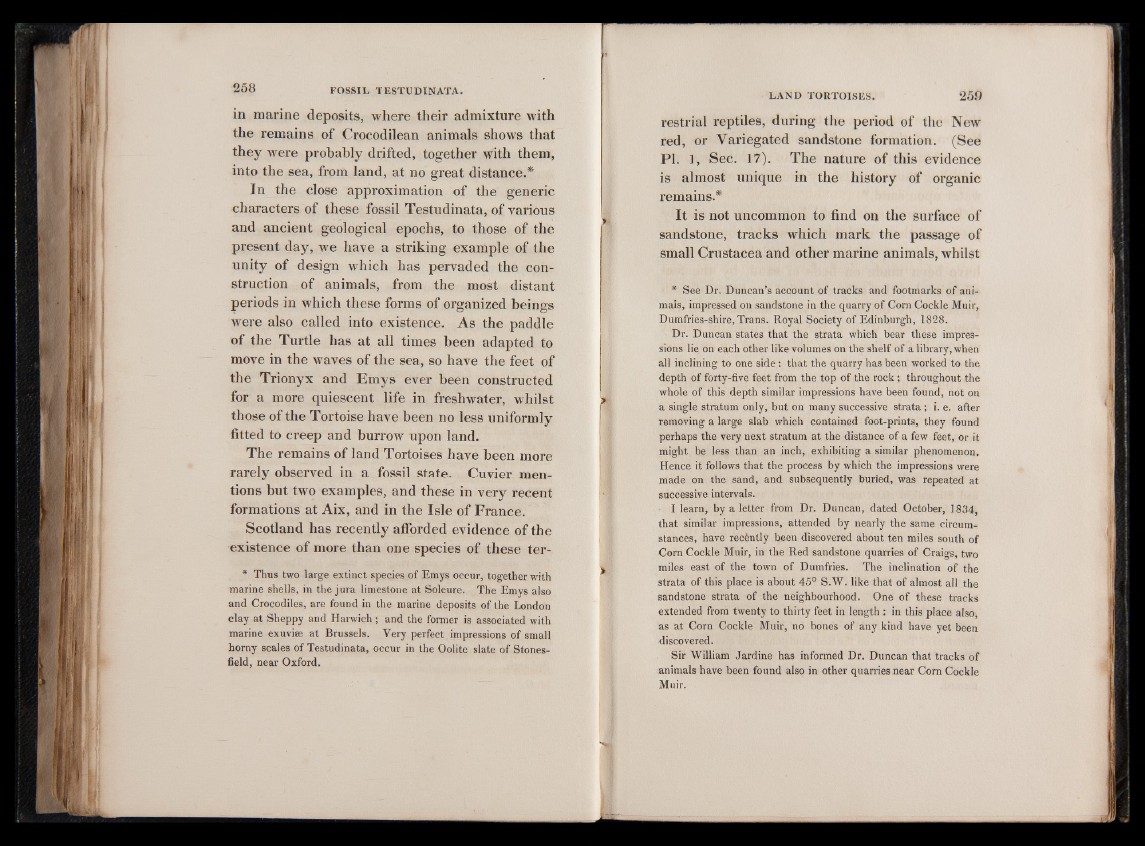
in marine deposits, where their admixture with
the remains of Croeodilean animals shows that
they were probably drifted, together with them,
into the sea, from land, at no great distance.*
In the close approximation of the generic
characters of these fossil Testudinata, of various
and ancient geological epochs, to those of the
present day, we have a striking example of the
unity of design which has pervaded the construction
of animals, from the most distant
periods in which these forms of organized beings
were also called into existence. As the paddle
of the Turtle has at all times been adapted to
move in the waves of the sea, so have the feet of
the Trionyx and Emys ever been constructed
for a more quiescent life in freshwater, whilst
those of the Tortoise have been no less uniformly
fitted to creep and burrow upon land.
The remains of land Tortoises have been more
rarely observed in a fossil state. Cuvier mentions
but two examples, and these in very recent
formations at Aix, and in the Isle of France.
Scotland has recently afforded evidence of the
existence of more than one species of these ter-
* Thus two large extinct species of Emys occur, together with
marine shells, in the jura limestone at Soleure. The Emys also
and Crocodiles, are found in the marine deposits of the London
clay at Sheppy and Harwich ; and the former is associated with
marine exuvise at Brussels. Very perfect impressions of small
horny scales of Testudinata, occur in the Oolite slate of Stones-
field, near Oxford.
restrial reptiles, during the period of the New
red, or Variegated sandstone formation. (See
PI. 1, Sec. 17). The nature of this evidence
is almost unique in the history of organic
remains.*
It is not uncommon to find on the surface of
sandstone, tracks which mark the passage of
small Crustacea and other marine animals, whilst
* See Dr. Duncan’s account of tracks and footmarks of animals,
impressed on sandstone in the quarry of Corn Cockle Muir,
Dumfries-shire, Trans. Royal Society of Edinburgh, 1828.
Dr. Duncan states that the strata which bear these impressions
lie on each other like volumes on the shelf of a library, when
all inclining to one side : that the quarry has been worked to the
depth of forty-five feet from the top of the rock ; throughout the
whole of this depth similar impressions have been found, not on
a single stratum only, but on many successive strata; i. e. after
removing a large slab which contained foot-prints, they found
perhaps the very next stratum at the distance of a few feet, or it
might be less than an inch, exhibiting a similar phenomenon.
Hence it follows that the process by which the impressions were
made on the sand, and subsequently buried, was repeated at
successive intervals.
I learn, by a letter from Dr. Duncan, dated October, 1834,
that similar impressions, attended by nearly the same circumstances,
have recently been discovered about ten miles south of
Corn Cockle Muir, in the Red sandstone quarries of Craigs, two
miles east of the town of Dumfries. The inclination of the
strata of this place is about 45° S.W. like that of almost all the
sandstone strata of the neighbourhood. One of these tracks
extended from twenty to thirty feet in length : in this place also,
as at Corn Cockle Muir, no bones of any kind have yet been
discovered.
Sir William Jardine has informed Dr. Duncan that tracks of
animals have been found also in other quarries near Corn Cockle
Muir.